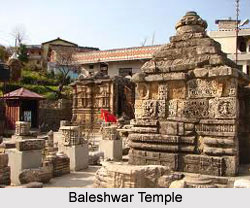 Baleshwar Temple was built by the rulers of the Chand dynasty. This temple is a great example of stone carving. There is no proof to reveal when the Baleshwar temple was built. However it is believed to have been built between the tenth and twelfth century AD.
Baleshwar Temple was built by the rulers of the Chand dynasty. This temple is a great example of stone carving. There is no proof to reveal when the Baleshwar temple was built. However it is believed to have been built between the tenth and twelfth century AD.
The main Baleshwar temple is dedicated to Lord Shiva who is known as Baleshwar. Beside these two temples there are two other temples in the compound of Baleshwar, one is dedicated to Ratneshwar and other to Champawati Durga. The temple is a good instance of South Indian Architecture with magnificent stone carving works. Nearby the Baleshwar Temple lies a "Naula" (freshwater resource) which has now dried up. The temple witnesses a fair on Mahashivratri. This temple has been declared an Indian National Heritage Monument.
This article is a stub. You can enrich by adding more information to it. Send your Write Up to content@indianetzone.com





















